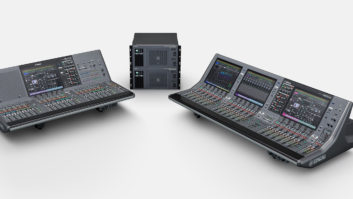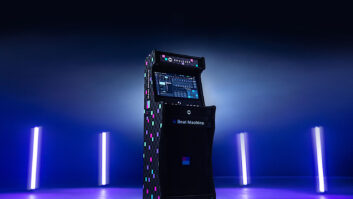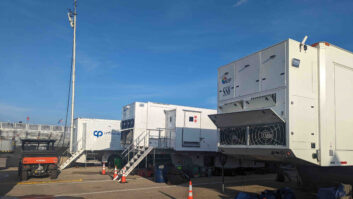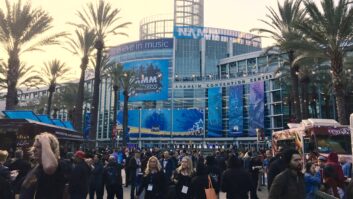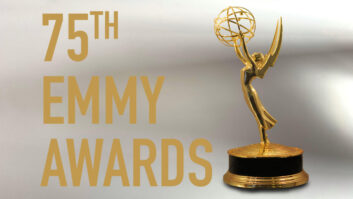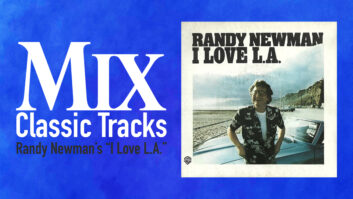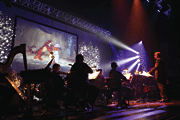
Imagine a concert featuring some of the hottest videogame music ever: from retro-classics like Super Mario Brothers, Frogger and Donkey Kong, to modern blockbuster titles such as God of War and Halo. Add a live symphony orchestra, choir and rock guitars, all performing to game footage being projected on a humongous screen — plus state-of-the-art, rock concert style lighting. Perhaps this is a glimpse of videogame nirvana?
That must have been exactly what game industry icons Tommy Tallarico and Jack Wall envisioned when they created Video Games Live (VGL). Tallarico explains, “My goal with Video Games Live is not only to celebrate the entire videogame industry, but to get this music out there to people who might not know videogame music. And if they come to this show, they’ll see and hear all of this and realize just how much of an art form videogames have become.”
Photo: Michelle Lee Wilson
NOT JUST FOR GAMERS
It all started on July 6, 2005, with a sold-out show at the Hollywood Bowl. Since then, VGL has embarked on a historic journey to concert halls around the globe, performing for generations of both gamers and non-gamers. “It’s great to see people supporting their loved ones’ enthusiasm of videogames,” Tallarico says. “After each show, a lot of non-gamers tell us that they found the performances both spectacular and beautiful, and they finally see why people enjoy videogames so much. We also feel it’s important to bring the power of the orchestra to younger generations who normally wouldn’t go to a concert hall to experience an orchestral performance.” There is also a festival before the show, which includes contests for best costume and best Guitar Hero shredder. Contestants receive cool prizes, while the best prizes — like Acer Ferrari laptops or cold, hard cash — are reserved for the winners.
Mix couldn’t pass up an opportunity to attend one of the shows in Phoenix in the newly built, world-class Ikeda Theater at the Mesa Arts Center.
Wall, a record producer and songwriter who has worked with David Byrne and Patti Smith, and who conducts the show’s orchestra, was inspired to score videogames when he played the original Myst game. Since becoming a videogame composer, he has scored music for such notable hit games as Jade Empire, Unreal II, Myst III: Exile and Myst IV: Revelation.

Matt Yelton stresses low end in his rock/orchestra mix.
Photo: Michel Henein
GUERRILLA TACTICS
Because the show uses a video projection system to display captured game footage on a large screen, the concert is driven by DVD. “Since this is a debut show, economics always become a factor,” Tallarico explains. “We opted to use a prosumer DVD player that pretty much drives everything. The image is being driven by a large video projector, while five channels of audio are coming from the DVD: a mono click track — which is being fed to Jack, the orchestra and choir — in addition to two stereo outputs that contain synth elements and percussion, which are being fed to the console and mixed with the live elements.”
SYMPHONIC SOUND, ROCK ‘N’ ROLL ATTITUDE
Front-of-house engineer Matt Yelton, who has worked with The Pixies, finds the VGL show challenging and exciting. “We could have gone with a more traditional symphonic sound, but I wanted the show to sound big, including lots of low end in the mix, using subwoofers to really rock the audience.
“We use local sound companies at each host city to provide equipment,” Yelton continues. “Because this show is so dynamic, I prefer to use a digital board, such as a Yamaha PM5D, for the recall. However, I’ll usually warm up the sound with tube compressors and EQs, in addition to using a nice analog compressor — Summit, et cetera — on the master bus.” For the FOH speaker system, Yelton prefers Meyer Sound, EAW or L-Acoustics V-DOSC arrays.
The ensemble is captured using a variety of different mics, which Yelton will add or subtract to the input list depending on the size of the local orchestra and choir. “I’m a big fan of DPA mics and use them as often as I can, but I have other mics that I use, as well,” says Yelton. “I have found, for instance, that using a pair of [Sennheiser] e604 tom mics for choir-left and -right works well because of their incredible rear rejection. But I’ll use a condenser, like [a Shure] SM81, to anchor the center of the choir.” For the orchestra, “I pretty much use SM81s for the strings, moved a bit closer for some edge in the mix, [and] also for brass and woodwinds, although for the French horns I’ll use a pair of SM57s,” says Yelton. “For percussion, I use a pair of [Sennheiser] e609s or SM57s for timpani and a large-diaphragm condenser for the remaining percussion.”
All of the monitors are also fed from FOH. “We run four monitor mixes through a Rane headphone mixer to an additional small [Mackie] mixer that sums the click system,” Yelton continues. “Both are placed where Jack is so he has control for the orchestra.”

Tommy Tallarico (left) with Jack Wall
Photo: Michel Henein
The orchestra’s mix comprises a mono click track, stereo percussion and backing tracks from the DVD. A mix is fed to each musician through Koss ED3TC single earphones. For the choir monitor mix, the setup calls for two to three wedges, depending on size. Yelton adds, “The choir gets the click track, some stereo percussion tracks and a hair of the extra stereo music tracks [from the DVD] for rhythm and to fill in the picture for them. Also, I’ll place synths and drones in their mix for pitching purposes, but the overall wedge volume for the choir is very low.” The soloists get a wedge mix that is rarely loud because they are usually unaccustomed to having sound reinforcement. The pianist receives the final mix, which is delivered on a wedge near the piano. “Most of the pieces performed do not use the back tracks from the DVD percussion loops and synths, generally,” Yelton adds, “but the click and count-off are always fed to the orchestra.”
HELLO INTERACTIVITY, MEET ORCHESTRA
“This show is all about having fun,” Wall says. “This isn’t like watching a traditional orchestral performance. As soon as the show starts, we rile up the audience and let it be known that they are going to have a blast.”
“We pull random members of the audience onstage and actually have them play a game live, competing with one another, while the orchestra plays along in real time,” Tallarico adds. “But to spice it up a bit, we throw up a countdown and time the players as they try to achieve the goal before running out of time.”
For one such interactive segment, an audience member comes onstage to play a game of Space Invaders. Wall conducts the orchestra so that it plays in time with the movements of the space aliens as they slowly inch their way toward the player on the giant screen — as the aliens speed up, so does the tempo. The player is given a big Fire button for shooting at the mother ship as it flies across the top of the screen; the twist here is that the player must physically move onstage to hide behind the virtual barriers in the game and avoid getting hit by the aliens shooting down. This gives the illusion that the player’s movements are being tracked and that the data is being updated directly to the game itself.
“Not so,” says Tallarico. “While it may seem we are using a state-of-the-art motion-capture system to pull this off, the reality is we have someone backstage with a feed off the player’s screen, in addition to a split off the joystick cable. So while the person onstage is physically moving around, someone in the back is just following that person moving left to right with a joystick, and all the player onstage has to do is avoid the onscreen bombs being dropped and fire at the mother ship. Each time the player hits the mother ship before the countdown expires, they win some cash.”
The evening ended with a grand finale in which music from Halo, both the original and the sequel, is performed beautifully alongside the stunning visuals from the games. The show, however, continued to blow us away with a preview clip of Halo 3, courtesy of Bungie, with the live orchestra performing music from the still-unreleased title — definitely a treat.
